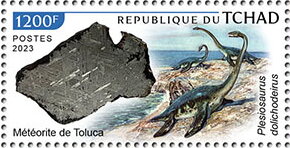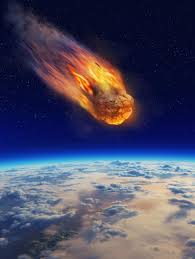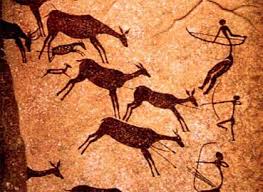Stamp: Plesiosaurus dolichodeirus, Toluca Meteorite (Chad 2023)
Plesiosaurus dolichodeirus, Toluca Meteorite (Chad 2023)
20 April (Chad ) within release Meteorites and Dinosaurs (2023) goes into circulation Stamp Plesiosaurus dolichodeirus, Toluca Meteorite face value 1,200 Central African CFA franc
| Stamp Plesiosaurus dolichodeirus, Toluca Meteorite in catalogues | |
|---|---|
| Yvert et Tellier: | Yt: TD 4540 |
Stamp is square format.
Also in the issue Meteorites and Dinosaurs (2023):
- Stamp - Ceratops horridus; Fragment of Henbury Meteorite face value 1,200;
- Stamp - Plesiosaurus dolichodeirus, Toluca Meteorite face value 1,200;
- Stamp - Pterodactylus antiquus, Camel Donga Meteorite face value 1,200;
Stamp Plesiosaurus dolichodeirus, Toluca Meteorite it reflects the thematic directions:
Animals are multicellular, eukaryotic organisms of the kingdom Animalia (also called Metazoa). All animals are motile, meaning they can move spontaneously and independently, at some point in their lives. Their body plan eventually becomes fixed as they develop, although some undergo a process of metamorphosis later on in their lives. All animals are heterotrophs: they must ingest other organisms or their products for sustenance.
Dinosaurs are a diverse group of reptiles of the clade Dinosauria. They first appeared during the Triassic period, between 243 and 233.23 million years ago (mya), although the exact origin and timing of the evolution of dinosaurs is a subject of active research. They became the dominant terrestrial vertebrates after the Triassic–Jurassic extinction event 201.3 mya and their dominance continued throughout the Jurassic and Cretaceous periods. The fossil record shows that birds are feathered dinosaurs, having evolved from earlier theropods during the Late Jurassic epoch, and are the only dinosaur lineage known to have survived the Cretaceous–Paleogene extinction event approximately 66 mya. Dinosaurs can therefore be divided into avian dinosaurs—birds—and the extinct non-avian dinosaurs, which are all dinosaurs other than birds.
A meteorite is a rock that originated in outer space and has fallen to the surface of a planet or moon. When the original object enters the atmosphere, various factors such as friction, pressure, and chemical interactions with the atmospheric gases cause it to heat up and radiate energy. It then becomes a meteor and forms a fireball, also known as a shooting star; astronomers call the brightest examples "bolides". Once it settles on the larger body's surface, the meteor becomes a meteorite. Meteorites vary greatly in size. For geologists, a bolide is a meteorite large enough to create an impact crater.
Prehistory, also called pre-literary history, is the period of human history between the first known use of stone tools by hominins c. 3.3 million years ago and the beginning of recorded history with the invention of writing systems. The use of symbols, marks, and images appears very early among humans, but the earliest known writing systems appeared c. 5,200 years ago. It took thousands of years for writing systems to be widely adopted, with writing spreading to almost all cultures by the 19th century. The end of prehistory therefore came at different times in different places, and the term is less often used in discussing societies where prehistory ended relatively recently.




